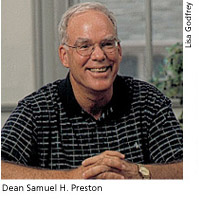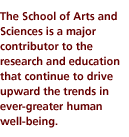
Dean's Column
Stayin' Alive

Not long before I was appointed dean of SAS, Kevin White, Gr’99,
M’01, a PhD. student in demography, and I wrote a paper that posed
the question, How many Americans are alive because of 20th century improvements
in mortality? Death rates plummeted over the last century as a result
of advances in medical science and public health. At the turn of the century,
life expectancy at birth was about 47 years. Today it is 77. The expansion
in longevity ranks among the great social achievements of our time. What
if this progress had never taken place, we asked, and the mortality rate
had remained unchanged?
The answer we arrived at, using counterfactual projections, is that one half of the current population would not be here. One-quarter of the populace would have been born and died, and another quarter would never have been born because their mothers or grandmothers would not have lived long enough to bear children. Nearly 140 million people in the U.S. today owe their very existence to a century of medical breakthroughs and modern personal and public health practices.
Our study gives eloquent testimony to the importance of health improvements. A recent article in Science magazine (10 May 2002) contains a graph that plots life expectancy as a function of time over 200 years. Using females from the country holding the record for longevity, the chart depicts a steep and unvarying climb from a life expectancy of age 45 in 1840 to a projected 95 years old by 2040. The numbers take the measure of what is a spectacular triumph of human initiative over nature.
 The
School of Arts and Sciences is a major contributor to the research and
education that continue to drive upward the trends in human well-being.
We prepare large numbers of pre-med students who will take up careers
that enhance the welfare of many. We offer a Health and Societies major
for undergraduates preparing for careers in the health professions or
for a health-care specialization in law, government, or business. The
School is also a key partner in the Vagelos Scholars Program in Molecular
Life Sciences, which lays a rigorous math and science foundation for tomorrow’s
science leaders. Together with Wharton and the engineering school, SAS
offers a dual graduate degree, Master of Biotechnology/MBA, and with the
medical school, a Master of Medical Physics.
The
School of Arts and Sciences is a major contributor to the research and
education that continue to drive upward the trends in human well-being.
We prepare large numbers of pre-med students who will take up careers
that enhance the welfare of many. We offer a Health and Societies major
for undergraduates preparing for careers in the health professions or
for a health-care specialization in law, government, or business. The
School is also a key partner in the Vagelos Scholars Program in Molecular
Life Sciences, which lays a rigorous math and science foundation for tomorrow’s
science leaders. Together with Wharton and the engineering school, SAS
offers a dual graduate degree, Master of Biotechnology/MBA, and with the
medical school, a Master of Medical Physics.
In addition to training tomorrow’s researchers, managers, and caregiver professionals, the School of Arts and Sciences supports many centers of cutting-edge science. Our chemistry department has yielded three Nobel laureates over the last five years, the most recent, Alan MacDiarmid, for collaborations and discoveries in laboratories here on campus. The School’s role in the new Genomics Institute and the Center for Bioinformatics will help keep Penn on the frontline of molecular biology and gene research, and on the far frontier of proteomics.
Fundamental science has, without question, led to a greater understanding of our bodies and the nature of pathogenic organisms—powerful knowledge that has helped prolong life. Unquestionably, the bulk of the advance in longevity is attributable to preventative rather than curative measures. In a broad sense, academic programming in the School of Arts and Sciences is also about prevention. It serves society by averting problems before they arise, whether preventing disease or the conflagrations that tear apart countries or groups of people.
For example, a liberal arts education informs graduates with a greater understanding of the bases of successful social organization and of cultural attributes that promote human advance. By encouraging us to see through the eyes of others, the liberal arts foster human understanding and create the basis for civil society and peaceful coexistence. Thanks in good measure to the spread of liberal education around the globe, there is a large and growing segment of the world where war is increasingly unlikely. The areas that are most likely to foment political violence are those where liberal education is discouraged because of its threat to traditional beliefs.
In medicine, efforts at disease prevention are often undervalued relative to curative measures because those for whom a disease has been prevented are typically unaware of their good fortune. We must make sure that prevention receives proper recognition not only in medicine but also in the academy. The alternative is to risk a withering of the roots that continue to nourish remarkable advances in human well-being.